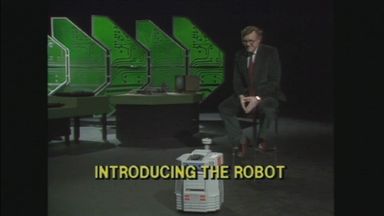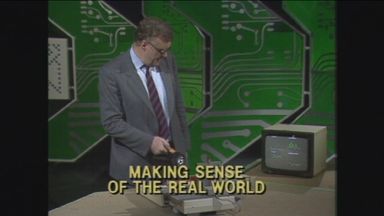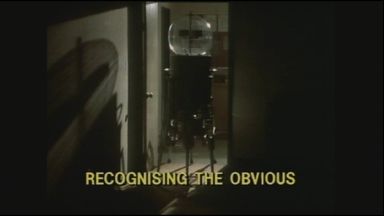Computers in Control
1. Introducing the Robot
Clips from this programme
Ian McNaught Davis is with 'Hero' - a hobbyist robot
Duration: 00:50At the Chicago robot exhibition, the sensors and actuators on Hero the hobbyist robot, Unimation industrial robots and a robot comedy routine on the Westinghouse stand.
Duration: 03:47Unimation robots have been around for twenty years but have lacked sophisticated computer control allowing them to perform precision tasks.
Duration: 00:15Modern robots welding in a car factory and machining plastic parts. A robot is any programmable, computer controlled mechanical device
Duration: 00:34Uncle Clunk is an animatronic figure destined for a pizza parlour
Duration: 00:14And the experimental Odetics spider-like robot can lift and move a car
Duration: 00:06Joe Engleberger of Westinghouse predicts future uses for robotics - e.g. in neurosurgery
Duration: 01:23The Westinghouse shaving robot plays a keyboard
Duration: 00:36Ian McNaught Davis shows a model robotic production line which is hard wired. To make it do something different, the logic circuits need to be altered by changing the wiring connections
Duration: 00:42Richard Fox of Westinghouse explains the difference between first, second and third generation robots: from dumb hardwired to systems to machines which recognise objects and can make decisions based on 'if then' and 'goto' commands
Duration: 01:59A third generation robot recognises and picks up a series of parts to make a switch
Duration: 00:43John Coll demonstrates a slow computer controlled conveyor belt system which can sort things by size and be reprogrammed to do different things. He explains sensors and actuators.
Duration: 02:54A very fast reactive (adaptive) system in a Lotus car monitors and controls the car's movements for a better ride.
Duration: 03:36John Coll demonstrates how a simple input and output can be interfaced to a BBC Micro and the program can be changed to make the output do different things via relay
Duration: 03:50A home made robotic system playing noughts and crosses uses a construction kit to lift and move pieces
Duration: 01:02A commercial chess playing machine with built in strategies
Duration: 01:12Computers in Control
1. Introducing the Robot
First broadcast: 2nd March 1984
Duration 24:42
An introduction to the world of robotics. 1: Introducing the Robot: A visit to the Chicago Robotics Exhibition shows how the computer has revolutionised these mechanical servants and even made domestic versions possible. IAN MCNAUGHT-DAVIS begins to look at how computers can sense what's going on round them and then control mechanical devices. Production DAVID ALLEN and ROBIN MUDGE
Now playing
2. Making Sense of the Real World
First broadcast: 9th March 1984
Duration 24:45
An introduction to the world of robotics. Making Sense of the Real World. How can the computer detect such widely different things as the whereabouts of a London Transport bus, fog, the length of an electronic flash or the speed of a motor? IAN MCNAUGHT -DAVIS and JOHN COLL look at a wide range of sensors which are available on the market. Production DAVID ALLEN and ROBIN MUDGE
3. Making Things Move
First broadcast: 16th March 1984
Duration 24:36
An introduction to the world of robotics. 3: Making Things Move: IAN MCNAUGHT-DAVIS continues his exploration of the principles behind the use of the computer in robotics by finding out how to make things move - even using a home micro. Production DAVID ALLEN and ROBIN MUDGE
4. Getting it Together
First broadcast: 23rd March 1984
Duration 24:23
An introduction to the world of robotics. 4: Getting it Together: IAN MCNAUGHT-DAVIS looks at some of the thinking behind more complex computer-controlled devices. Production DAVID ALLEN and ROBIN MUDGE
5. Recognising the Obvious
First broadcast: 30th March 1984
Duration 24:36
An introduction to the world of robotics 5: Recognising the Obvious : We see, hear and interpret the real world with ease. For the computer it's not so easy, but some robotic systems can identify objects or voices and act accordingly, and it's possible to mimic these on the home microcomputer. Production DAVID ALLEN and ROBIN MUDGE























